Fuel Sender Assembly Replacement VIN K
Removal Procedure
Tools Required
| • | J 34730-1A Fuel Pressure Gauge |
| • | J 39765 Fuel Sender Lock Nut Wrench |
Caution: Gasoline or gasoline vapors are highly flammable. A fire could occur if an ignition source is present. Never drain or store gasoline or diesel fuel in an open container, due to the possibility of fire or explosion. Have a dry chemical (Class B) fire extinguisher nearby.
Caution: Provide proper ventilation when working with fuel in enclosed areas where fuel vapors can collect. The lack of adequate ventilation may result in personal injury.
Caution: Always wear safety goggles when working with fuel in order to protect the eyes from fuel splash.
Caution: Fuel Vapors can collect while servicing fuel system parts in enclosed
areas such as a trunk. To reduce the risk of fire and increased exposure to
vapors:
• Use forced air ventilation such as a fan set outside
of the trunk. • Plug or cap any fuel system openings in order to reduce fuel vapor
formation. • Clean up any spilled fuel immediately. • Avoid sparks and any source of ignition. • Use signs to alert others in the work area that fuel system work
is in process.
Notice: Clean all of the following areas before performing any disconnections
in order to avoid possible contamination in the system:
• The fuel pipe connections • The hose connections • The areas surrounding the connections
Notice: Do Not handle the fuel sender assembly by the fuel pipes. The amount of leverage generated by handling the fuel pipes could damage the joints.
Notice: Replace the fuel sender O-rings when re-installing the fuel sender in order to avoid damage to the fuel sender assembly.
- Relieve the fuel system fuel pressure. Refer to the Fuel Pressure Relief .
- Drain the fuel tank (1) to at least 3/4 of a tank full. Refer to Fuel Tank Draining .
- Remove the spare tire cover, jack, and the spare tire.
- Remove the rear compartment trim. Refer to Rear Compartment Trim Panel Replacement .
- Remove the fuel sender access panel (1).
- Clean all of the fuel pipe connections, all of the hose connections, and all of the areas surrounding the connections before disconnecting the connections in order to avoid possible contamination of the fuel system.
- Remove the quick-connect fittings at the fuel sender assembly. Refer to Plastic Collar Quick Connect Fitting Service .
- Remove the electrical connector at the fuel sender.
- Remove the electrical connector at the fuel tank pressure sensor.
- Remove the fuel sender retaining ring using the J 39675 Fuel Sender Spanner Wrench.
- Remove the fuel sender assembly retaining cam, using the J 39675 Fuel Sender Spanner Wrench.
- Remove the fuel sender assembly and the O-ring from the fuel tank.
- Discard the fuel sender assembly O-ring.
- Clean the fuel sender assembly O-ring sealing surfaces.
- Inspect the fuel sender assembly O-ring sealing surfaces.
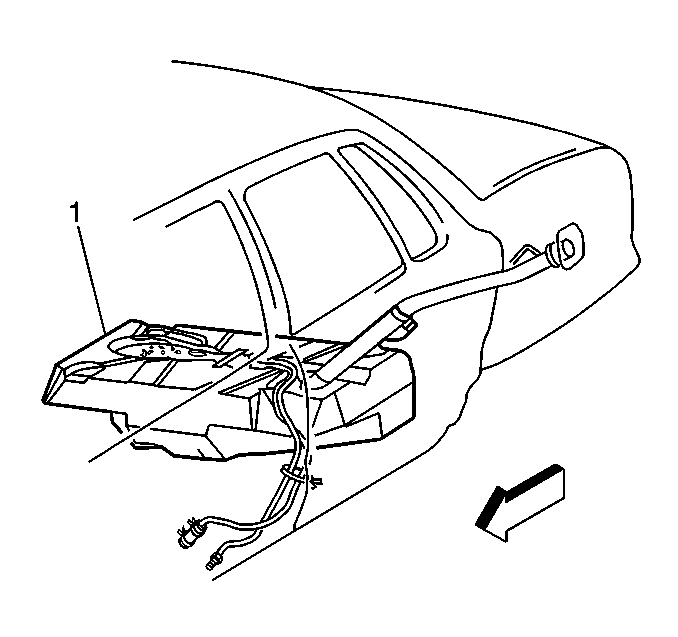
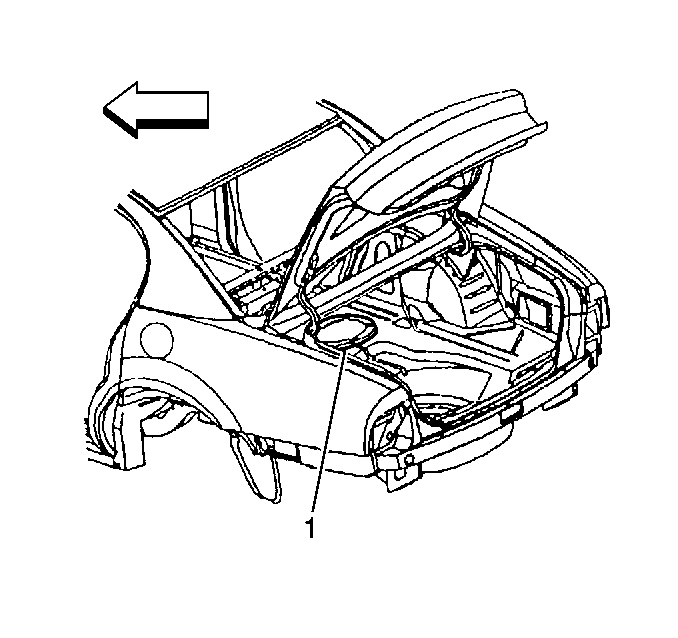
Caution: Remove the rear compartment floor trim to provide technician contact with the vehicle's metal surfaces. Failure to remove the rear compartment floor trim may cause a static electricity discharge to ignite any fuel vapor resulting in personal injury and vehicle damage.
Notice: Remove the rear compartment floor trim to avoid damage from fuel spillage.

Notice: Remove the rear compartment floor trim to avoid damage from fuel spillage.
Important: The modular fuel sender will spring-up when the retaining cam is removed.
Important: When removing the modular fuel sender assembly from the fuel tank, the reservoir bucket on the fuel sender assembly is full of fuel. The fuel sender assembly must be tipped slightly during removal in order to avoid damage to the float. Place any remaining fuel into an approved container once the fuel sender assembly is removed from the tank.

Installation Procedure
Notice: Always re-attach the fuel lines and fuel filter with all original type fasteners and hardware.
Do not repair sections of fuel pipes.- Position the new fuel sender assembly O-ring on the fuel tank.
- Assemble the fuel sender assembly and the fuel sender assembly retainer cam using the J 39675 Fuel Sender Spanner Wrench.
- Install the fuel sender assembly and the fuel sender assembly retainer cam using the J 39765 Fuel Sender Spanner Wrench.
- Install the quick-connect fittings at the fuel sender assembly. Refer to Plastic Collar Quick Connect Fitting Service .
- Install the electrical connector at the fuel tank pressure sensor.
- Install the electrical connector at the fuel sender assembly.
- Install the negative battery cable. Refer to Battery Cable Replacement .
- Inspect for leaks.
- Install the fuel sender access panel.
- Install the rear compartment floor trim. Refer to Rear Compartment Trim Panel Replacement .
- Install the spare tire, the jack, and the spare tire cover.
- Add fuel and install the fuel tank filler pipe cap.

Important: Always replace the fuel sender O-ring when the reinstalling the fuel sender assembly.
Important: Care should be taken not to fold over or twist the fuel pump strainer when installing the fuel sender assembly, as this will restrict fuel flow. Also, assure that the fuel pump strainer does not block full travel of float arm.
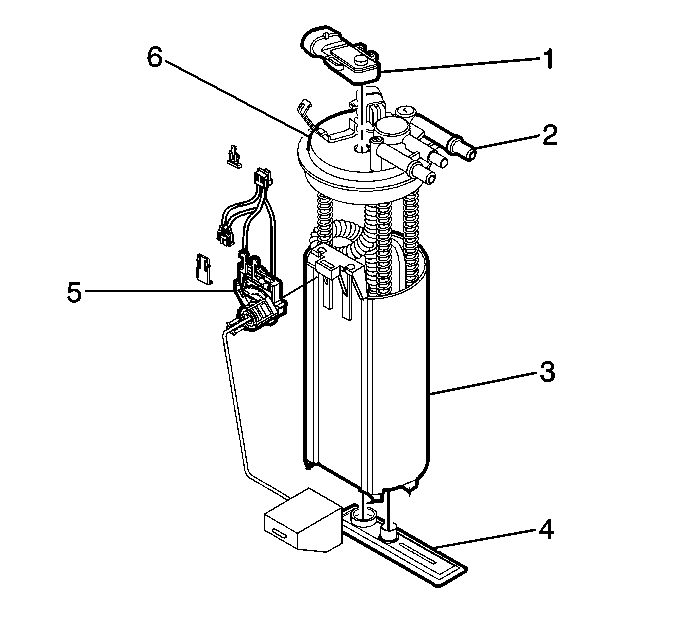
Important: Care should be taken not to fold over or twist the fuel pump strainer (4) when installing the fuel sender assembly, as this will restrict fuel flow. Also, assure that the fuel pump strainer does not block full travel of float arm.

| 8.1. | Turn the ignition switch On for 2 seconds. |
| 8.2. | Turn the ignition switch Off for 10 seconds. |
| 8.3. | Turn the ignition switch On. |
| 8.4. | Check for fuel leaks. |
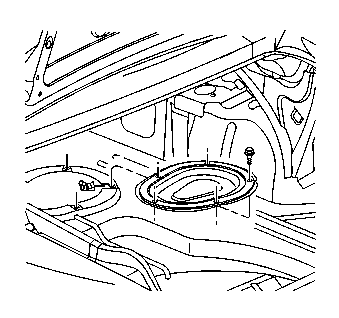
Notice: Use the correct fastener in the correct location. Replacement fasteners must be the correct part number for that application. Fasteners requiring replacement or fasteners requiring the use of thread locking compound or sealant are identified in the service procedure. Do not use paints, lubricants, or corrosion inhibitors on fasteners or fastener joint surfaces unless specified. These coatings affect fastener torque and joint clamping force and may damage the fastener. Use the correct tightening sequence and specifications when installing fasteners in order to avoid damage to parts and systems.
Tighten
Tighten the bolts to 2 N·m (18 lb in).
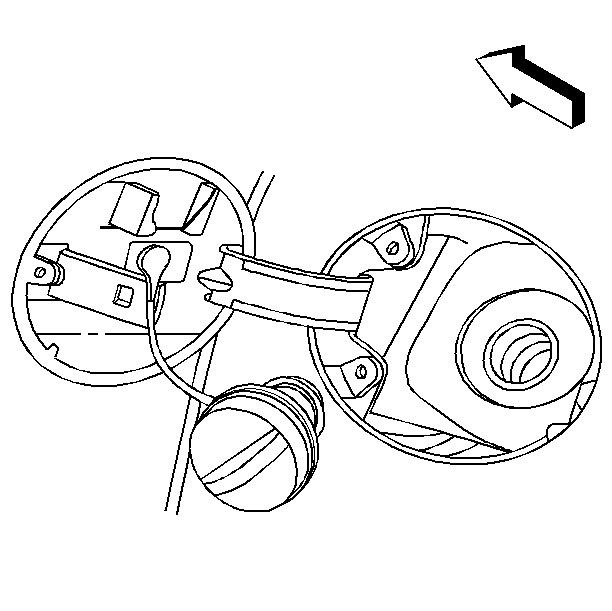
Fuel Sender Assembly Replacement VIN 1
Removal Procedure
Tools Required
| • | J 34730-1A Fuel Pressure Gauge |
| • | J 39765 Fuel Sender Lock Nut Wrench |
Caution: Gasoline or gasoline vapors are highly flammable. A fire could occur if an ignition source is present. Never drain or store gasoline or diesel fuel in an open container, due to the possibility of fire or explosion. Have a dry chemical (Class B) fire extinguisher nearby.
Caution: Provide proper ventilation when working with fuel in enclosed areas where fuel vapors can collect. The lack of adequate ventilation may result in personal injury.
Caution: Always wear safety goggles when working with fuel in order to protect the eyes from fuel splash.
Caution: Fuel Vapors can collect while servicing fuel system parts in enclosed
areas such as a trunk. To reduce the risk of fire and increased exposure to
vapors:
• Use forced air ventilation such as a fan set outside
of the trunk. • Plug or cap any fuel system openings in order to reduce fuel vapor
formation. • Clean up any spilled fuel immediately. • Avoid sparks and any source of ignition. • Use signs to alert others in the work area that fuel system work
is in process.
Notice: Clean all of the following areas before performing any disconnections
in order to avoid possible contamination in the system:
• The fuel pipe connections • The hose connections • The areas surrounding the connections
Notice: Do Not handle the fuel sender assembly by the fuel pipes. The amount of leverage generated by handling the fuel pipes could damage the joints.
Notice: Replace the fuel sender O-rings when re-installing the fuel sender in order to avoid damage to the fuel sender assembly.
- Relieve the fuel system fuel pressure. Refer to the Fuel Pressure Relief .
- Drain the fuel tank to at least 3/4 of a tank full. Refer to Fuel Tank Draining .
- Remove the spare tire cover, jack, and the spare tire.
- Remove the rear compartment trim. Refer to Rear Compartment Trim Panel Replacement .
- Remove the fuel sender access panel (1).
- Clean all of the fuel pipe connections, all of the hose connections, and all of the areas surrounding the connections before disconnecting the connections in order to avoid possible contamination of the fuel system.
- Remove the quick-connect fittings at the fuel sender assembly. Refer to Plastic Collar Quick Connect Fitting Service .
- Remove the electrical connector at the fuel sender.
- Remove the electrical connector at the fuel tank pressure sensor.
- Remove the fuel sender retaining ring using the J 39675 Fuel Sender Spanner Wrench.
- Remove the fuel sender assembly retaining cam, using the J 39675 Fuel Sender Spanner Wrench.
- Remove the fuel sender assembly and the O-ring from the fuel tank.
- Discard the fuel sender assembly O-ring.
- Clean the fuel sender assembly O-ring sealing surfaces.
- Inspect the fuel sender assembly O-ring sealing surfaces.


Caution: Remove the rear compartment floor trim to provide technician contact with the vehicle's metal surfaces. Failure to remove the rear compartment floor trim may cause a static electricity discharge to ignite any fuel vapor resulting in personal injury and vehicle damage.
Notice: Remove the rear compartment floor trim to avoid damage from fuel spillage.

Notice: Remove the rear compartment floor trim to avoid damage from fuel spillage.
Important: The modular fuel sender will spring-up when the retaining cam is removed.
Important: When removing the modular fuel sender assembly from the fuel tank, the reservoir bucket on the fuel sender assembly is full of fuel. The fuel sender assembly must be tipped slightly during removal in order to avoid damage to the float. Place any remaining fuel into an approved container once the fuel sender assembly is removed from the tank.

Installation Procedure
Notice: Always re-attach the fuel lines and fuel filter with all original type fasteners and hardware.
Do not repair sections of fuel pipes.- Position the new fuel sender assembly O-ring on the fuel tank.
- Assemble the fuel sender assembly and the fuel sender assembly retainer cam using the J 39675 Fuel Sender Spanner Wrench.
- Install the fuel sender assembly and the fuel sender assembly retainer cam using the J 39765 Fuel Sender Spanner Wrench.
- Install the quick-connect fittings at the fuel sender assembly. Refer to Plastic Collar Quick Connect Fitting Service .
- Install the electrical connector at the fuel tank pressure sensor.
- Install the electrical connector at the fuel sender assembly.
- Install the negative battery cable. Refer to Battery Cable Replacement .
- Inspect for leaks.
- Install the fuel sender access panel.
- Install the rear compartment floor trim. Refer to Rear Compartment Trim Panel Replacement .
- Install the spare tire, the jack, and the spare tire cover.
- Add fuel to the fuel tank.
- Install the fuel tank filler pipe cap.

Important: Always replace the fuel sender O-ring when the reinstalling the fuel sender assembly.
Important: Care should be taken not to fold over or twist the fuel pump strainer when installing the fuel sender assembly, as this will restrict fuel flow. Also, assure that the fuel pump strainer does not block full travel of float arm.

Important: Care should be taken not to fold over or twist the fuel pump strainer (4) when installing the fuel sender assembly, as this will restrict fuel flow. Also, assure that the fuel pump strainer does not block full travel of float arm.

| 8.1. | Turn the ignition switch On for 2 seconds. |
| 8.2. | Turn the ignition switch Off for 10 seconds. |
| 8.3. | Turn the ignition switch On. |
| 8.4. | Check for fuel leaks. |

Notice: Use the correct fastener in the correct location. Replacement fasteners must be the correct part number for that application. Fasteners requiring replacement or fasteners requiring the use of thread locking compound or sealant are identified in the service procedure. Do not use paints, lubricants, or corrosion inhibitors on fasteners or fastener joint surfaces unless specified. These coatings affect fastener torque and joint clamping force and may damage the fastener. Use the correct tightening sequence and specifications when installing fasteners in order to avoid damage to parts and systems.
Tighten
Tighten the bolts to 2 N·m (18 lb in).

